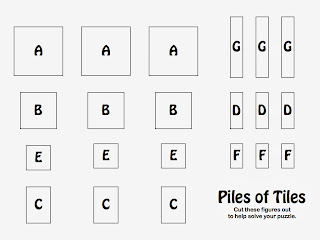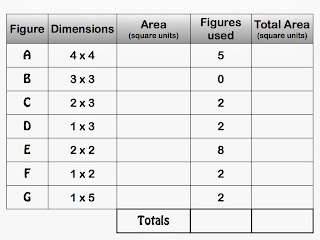There's a lot going on here; game boards, tiles, dice, cards, bell-bottoms, shag carpeting. Instead of typing up the directions, amuse yourself with these:
The tiles look like plastic jello.
The cards offer some opportunities for strategy throughout the game.
There are many things I like about this game, even though I have never played it. I like the spatial reasoning component, the challenge of placing tiles depending on what you roll with the dice (and the order in which you have to place them), and the demand for strategy that the cards present. I didn't like reading through all the directions to discover all the nuances. Some parts of the game are not intuitive. However, I really like what is intuitive: placing the tiles on your game board in the best way possible to cover the most area (square units) of the game board earning the most amount of points.
I brought the box home to create some adaptations for my students. Here's phase 1: Piles of Tiles. Having recently blogged about weekly POPS, Piles of Tiles will become an additional option for the first P (Patterns/Puzzles) in POPS. In phase 1, I'd like my students to play around with the Piles of Tiles puzzle like this:
I'll pass out this sheet (maybe two) to students and have them cut out all of the figures. They can keep their cut-outs in a plastic sandwich bag.
The student game board will look like this.
Students can use their cut-outs to fill the 12x12 board with the specific tiles, found in the table at the bottom of the page. Once they have their solution, they can outline each figure within the game board and specify which section refers to figure A, B, C, and so on. They can use colored pencil or crayons to keep each similar figure the same color. For you detailed people, I made the grid so it prints each square unit as 1 cm by 1 cm. Therefore, you get a total of 144 square centimeters. AWESOME!
Students can stay organized and also submit the following to me:
All the Piles of Tiles goods (blank templates) can be found in my weekly POPS folder.
My goals (right now) are to get students to:
- manipulate shapes through rotations and translations
- build their spatial reasoning
- recognize there are multiple solutions
- organize their data
- have a better understanding of area
I'm open to suggestions or feedback, so please let me know.
Since we're on the topic of puzzles, ThinkFun has some great puzzles (as I've mentioned before). Go over to their site and check out these Big Games group activities to use with students. Many of the activities are puzzles you might have seen on paper somewhere, but they rewrote them as group activities to foster collaboration, spatial reasoning, and problem-solving amongst students.
Piles of Tiles,
1032








